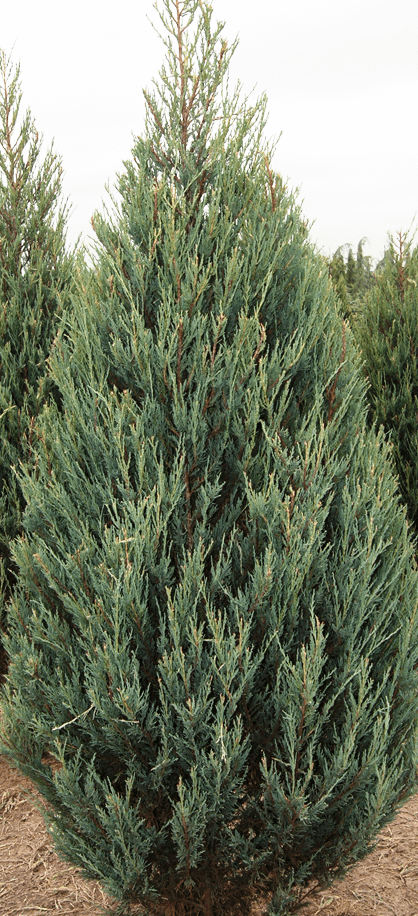

Deer don't particularly care for this plant and will usually leave it alone in favor of tastier treats. This is a high maintenance shrub that will require regular care and upkeep, and is best pruned in late winter once the threat of extreme cold has passed.

It lends an extremely fine and delicate texture to the landscape composition which can make it a great accent feature on this basis alone. Skyrocket Juniper is a multi-stemmed evergreen shrub with a narrowly upright and columnar growth habit. It produces silvery blue berries from late spring to late winter. The scale-like sprays of foliage are highly ornamental and remain powder blue throughout the winter. It has attractive powder blue evergreen foliage. Skyrocket Juniper is a dwarf conifer which is primarily valued in the landscape for its rigidly columnar form. Our Growing Place Choice plants are chosen because they are strong performers year after year, staying attractive with less maintenance when planted in the right place. Check out our inventory & pricing page to see our up to date product inventory by clicking here.An extremely narrow, rigid tall evergreen shrub, with soft blue-green needle-like foliage all season long use with caution, can be rather abrupt in the landscape, makes a curious, almost formal tall evergreen hedge when planted in a row If you live in the Dallas-Fort Worth area and are interested in incorporating Taylor Junipers into your landscape make sure to give us a call. Eastern Red Cedar ‘Taylor’ Aka Taylor Junipers, planted to flank and enhance an entrance. Eastern Red Cedar ‘Taylor’ Aka Taylor Junipers, planted to create a privacy screen.Įastern Red Cedar ‘Taylor’ Aka Taylor Junipers, planted along a wall. Checkout our online galleries to view different installations using Taylor Junipers.

Most landscapes incorporate Taylor Junipers by planted them as hedges in narrow areas between a pool and fence or as accent pieces flanking doorways. The leaves are also a tinge more blue/green than the green Italian Cypress. This handsome tree maintains a more dense foliage than the Italian Cypress. With this introduction of the Taylor Juniper all of those issues are solved while keeping the desired look of an Italian Cypress. This makes for a more water conscious landscape and responsible landscaping.Įastern Red Cedars and their cultivars are naturally more disease resistant than the Italian Cypress. For years Italian Cypress trees have been thrust into landscapes throughout Dallas Metroplex because of their unique shape but they have a lot of issues which include: Phytophthora Root Rot, Seridium Canker, Spider Mites and they are susceptible to cold weather. After Eastern Red Cedars are watered for about 2 years and the roots have developed then they are able to sustain themselves without weekly waterings. The Taylors can be planted in zones 3-9, with North Texas falling under zone 8.Įastern Red Cedars are Native to Texas and do very well in our Texas Summers, therefore the Taylors which are a cultivar of them also get to reap those drought & heat tolerant benefits. We talked with a vendor up North, and they have a hard time keeping this tree stocked up there because it does so well. As many know, the weather can be pretty brutally cold in Nebraska, and the Taylor Juniper not only withstands such weather, but thrives in it. The Taylor Juniper was actually first discovered in Taylor Nebraska, hence it’s namesake. WHAT MAKES THE TAYLOR JUNIPER A BETTER TREE THAN THE ITALIAN CYPRESS? Eastern Red Cedar ‘Taylor’ Aka Taylor Junipers, planted between a pool and fence. Since then this tree has been a wonderful replacement for our customers who love the columar look of Italian Cypress trees, but don’t like the negative traits they have. After lots of research and trials we decided to introduce the Eastern Red Cedar ‘Taylor’ aka Taylor Juniper. While there have been many debates about what caused so many Italian Cypress trees to start turning brown and some even die, all of us in the industry can agree that it all started with the freezes and dramatic temperature fluctuations that December.Īfter the huge losses that we had a the farm we made the tough decision to take the Italian Cypress off our inventory offerings for good. It wasn’t until the major freezes in the Winter of 2016 that we really realized the weaknesses of this tree.

The Italian Cypress was a long favorite for North Texans.


 0 kommentar(er)
0 kommentar(er)
